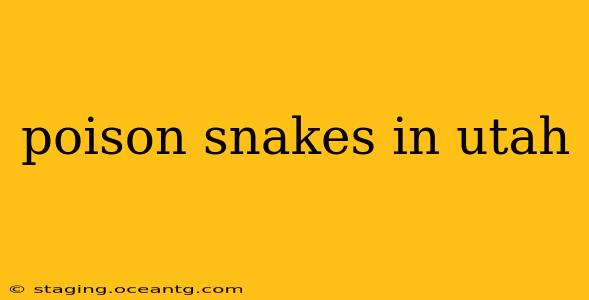Utah's diverse landscape, ranging from arid deserts to mountainous regions, harbors a variety of snake species, some of which are venomous. Understanding which snakes are poisonous and how to react to a bite is crucial for anyone spending time outdoors in the state. This guide provides comprehensive information on venomous snakes found in Utah, safety tips, and what to do in case of a snakebite.
What types of venomous snakes live in Utah?
Utah is home to several species of venomous snakes, all belonging to the pit viper family (Crotalidae). These snakes possess heat-sensing pits between their eyes and nostrils, allowing them to detect warm-blooded prey. The most common venomous snakes in Utah are:
-
Western Diamondback Rattlesnake (Crotalus atrox): This is arguably the most well-known and widespread venomous snake in Utah. It's easily identifiable by its characteristic diamond-shaped markings and, of course, its rattle. These snakes can grow quite large, and their venom is potent.
-
Great Basin Rattlesnake (Crotalus oreganus lutosus): This rattlesnake subspecies is common in mountainous areas of Utah. Its coloration can vary depending on its habitat, but it typically features dark brown or grayish-brown blotches on a lighter background.
-
Mojave Rattlesnake (Crotalus scutulatus): This species is found in the southwestern part of the state. While less common than the other rattlesnakes, its venom is highly toxic and requires immediate medical attention. It can be difficult to distinguish from other rattlesnakes, emphasizing caution when encountering any rattlesnake.
It's important to note that while these are the most common venomous snakes, other potentially venomous species might exist in more remote areas. Always exercise caution when handling any snake.
Are there any other poisonous snakes besides rattlesnakes in Utah?
No, there are no other species of poisonous snakes in Utah besides the rattlesnakes listed above. While some non-venomous snakes might be mistaken for venomous ones, the only poisonous snakes in the state are pit vipers, all belonging to the Crotalus genus (rattlesnakes).
How can I identify a poisonous snake in Utah?
Identifying a poisonous snake requires caution and careful observation. Never attempt to handle a snake you suspect is venomous. Key identifying features of Utah's venomous snakes include:
-
Rattles: The most obvious feature is the rattle at the end of the tail. However, young rattlesnakes may have a button instead of a fully developed rattle.
-
Triangular Head: Venomous snakes have a distinctly triangular-shaped head, broader behind the eyes.
-
Heat-Sensing Pits: Located between the eyes and nostrils, these pits allow them to detect infrared radiation (heat) from their prey.
-
Elliptical Pupils: Unlike most non-venomous snakes, venomous snakes typically have elliptical or slit-like pupils.
-
Coloration and Patterns: While color and patterns can vary, look for the diamond patterns characteristic of Western Diamondback rattlesnakes or the blotches of the Great Basin rattlesnake.
What should I do if I see a rattlesnake in Utah?
Encountering a rattlesnake requires calm and careful action:
-
Maintain a Safe Distance: Do not approach the snake. Give it a wide berth and slowly back away.
-
Avoid Sudden Movements: Sudden movements can startle the snake and increase the likelihood of a bite.
-
Keep Pets Away: Keep pets and children away from the snake.
-
Educate Others: If you are with others, make sure everyone maintains a safe distance.
-
Report Sightings: If you encounter a rattlesnake in a populated area, it's advisable to report the sighting to local authorities or wildlife agencies.
What should I do if I am bitten by a poisonous snake in Utah?
A snakebite is a medical emergency. Follow these steps:
-
Remain Calm: Panic can increase your heart rate and spread the venom faster.
-
Immobilize the Affected Limb: Keep the bitten area still and below the level of your heart to slow venom spread.
-
Remove Any Jewelry or Tight Clothing: Swelling can occur rapidly, so removing these items is crucial.
-
Seek Immediate Medical Attention: Call emergency services immediately and seek medical attention.
-
Do NOT: Attempt to suck out the venom, apply a tourniquet, or use any home remedies. These actions can be harmful and ineffective.
How common are snakebites in Utah?
While rattlesnake encounters are relatively common in Utah, actual bites are statistically less frequent. Most snakebites occur when people accidentally step on a snake, attempt to handle a snake, or are otherwise unintentionally provoking the reptile. By following safety precautions and respecting wildlife, you can significantly reduce the risk of a snakebite.
This information is for general knowledge and should not be considered a substitute for professional medical advice. If bitten by a snake, seek immediate medical attention. Remember, responsible behavior and awareness are your best defense against snakebites in Utah.
